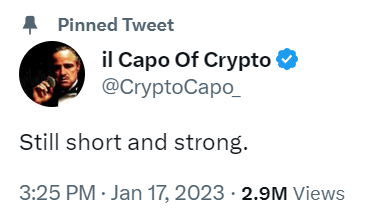The stock market is a place of great opportunity, but also of great risk. One of the biggest risks for investors is the bull trap, a phenomenon where a market appears to be trending upwards, but suddenly and unexpectedly reverses course and starts to decline. This is often caused by a sudden shift in investor sentiment, which can be triggered by a range of factors, including economic data, political developments, or market news.
Recently, Capo10k, a renowned trader, observed ONE OF THE BIGGEST BULL TRAPS I´VE EVER SEEN. In this article, we will examine the anatomy of this bull trap, from the build-up to the trap itself, and finally to the aftermath. We will also explore the lessons that can be learned from this event.
Introduction to Bull Traps

Before we dive into the specifics of this bull trap, let's first review the basic characteristics of a bull trap. A bull trap is a market situation in which the market appears to be trending upwards, luring investors into buying in, only to reverse course suddenly and trap those investors. The market then starts to decline, causing those investors to incur losses.
Bull traps can occur in any market, whether it's stocks, commodities, or cryptocurrencies. They are often caused by a sudden shift in market sentiment, which can be triggered by a range of factors, including economic data, political developments, or market news. Bull traps can be difficult to predict, as they often occur suddenly and unexpectedly.
The Build-up to the Trap

In the case of the recent bull trap observed by Capo10k, the build-up to the trap was characterized by a period of bullish sentiment in the stock market. Investors had been optimistic about the prospects for the economy, and many were expecting a strong recovery in the wake of the pandemic.
This optimism was reflected in the performance of the stock market, which had been trending upwards for several months. Many investors were lured in by this bullish sentiment, and started buying into the market, expecting to make significant profits.
However, there were warning signs that the bullish sentiment might be overextended. Some economic data had started to show signs of weakness, and there were concerns about rising inflation. Some investors had started to take profits, and there were signs of selling pressure in the market.
The Trap is Set

Despite these warning signs, many investors remain bullish on the market, and continue to buy in. This created a situation where the market appeared to be trending upwards, but was actually being propped up by a relatively small group of investors.
This created the perfect conditions for a bull trap. When the market suddenly reversed course, many of these investors were caught off guard. They had expected the market to continue trending upwards, and had invested accordingly. When the market started to decline, they were forced to sell their positions, incurring significant losses.
In this case, the trigger for the reversal was a sudden shift in investor sentiment, caused by a range of factors, including concerns about inflation and rising interest rates. This triggered a wave of selling, which quickly snowballed, causing the market to decline rapidly.
The Aftermath
The aftermath of the bull trap was brutal for many investors. Those who had bought in near the top of the market were left with significant losses, and many were forced to sell their positions in order to cut their losses.
However, there were also some investors who were able to weather the storm. Those
who had diversified their portfolios and had not invested too heavily in the market were able to minimize their losses. Some investors also took advantage of the decline to buy in at lower prices, in the hopes of making a profit when the market eventually recovered.
Overall, the aftermath of the bull trap was a stark reminder of the risks of investing in the stock market. It was a wake-up call for many investors, who realized that even the most bullish markets can turn on a dime, and that investing in the stock market requires careful risk management and a long-term perspective.
Lessons Learned

So, what are the lessons that can be learned from this bull trap? Here are a few key takeaways:
- Be mindful of market sentiment: Bull traps often occur when market sentiment becomes too bullish. It's important to pay attention to warning signs that sentiment may be overextended, and to take profits or adjust your portfolio accordingly.
- Diversify your portfolio: Diversification is key to managing risk in the stock market. By investing in a range of assets, you can minimize your exposure to any single market or sector, and reduce the impact of a sudden decline in any one area.
- Don't invest more than you can afford to lose: The stock market is inherently risky, and investing always carries the potential for loss. It's important to invest only what you can afford to lose, and to avoid investing with money that you need in the short term.
- Take a long-term perspective: Investing in the stock market requires patience and a long-term perspective. While short-term gains can be tempting, it's important to focus on the long-term potential of your investments, and to avoid making impulsive decisions based on short-term market fluctuations.
Conclusion
The recent bull trap observed by Capo10k was a stark reminder of the risks of investing in the stock market. While the market can offer great opportunities for those who are willing to take on some risk, it's important to approach investing with caution and careful risk management. By being mindful of market sentiment, diversifying your portfolio, investing only what you can afford to lose, and taking a long-term perspective, you can minimize your risk and increase your chances of success in the stock market.